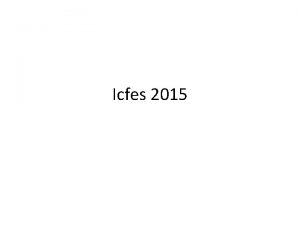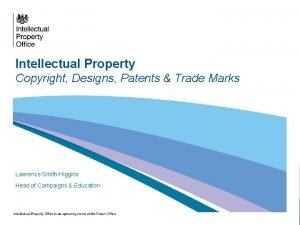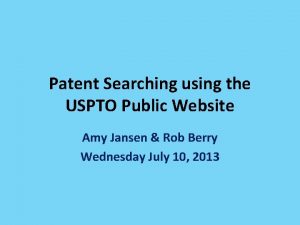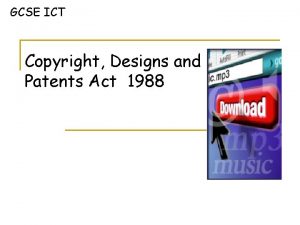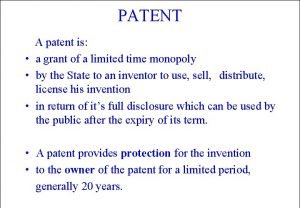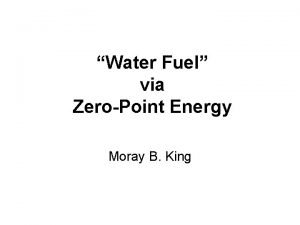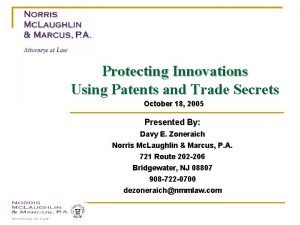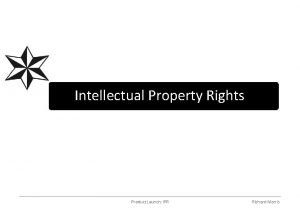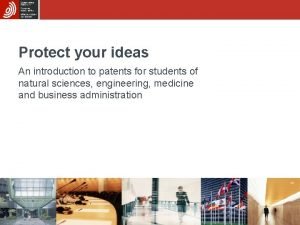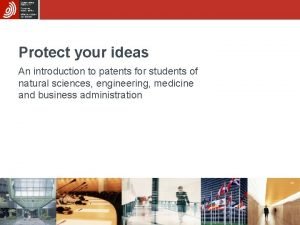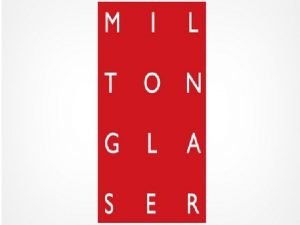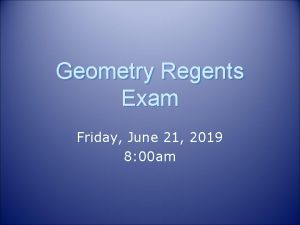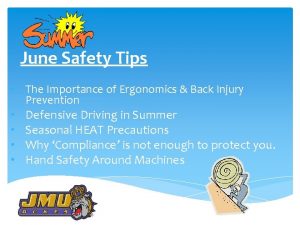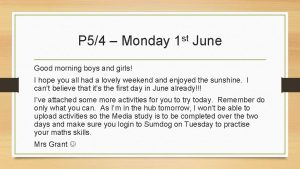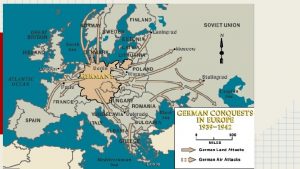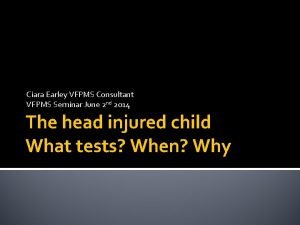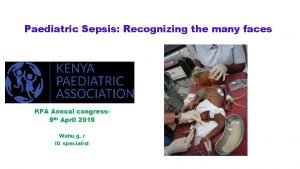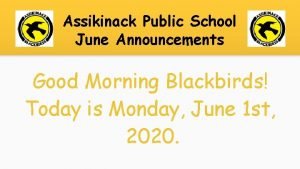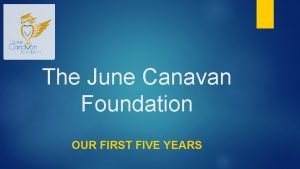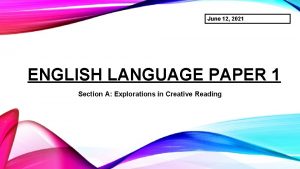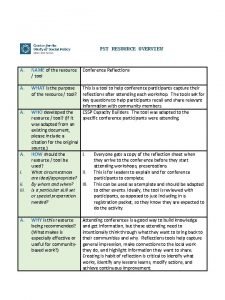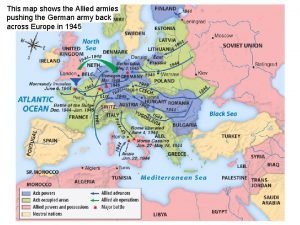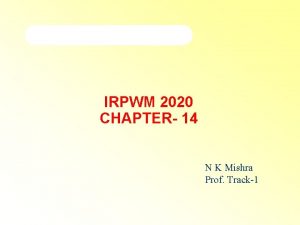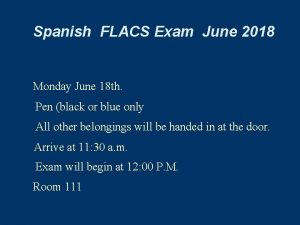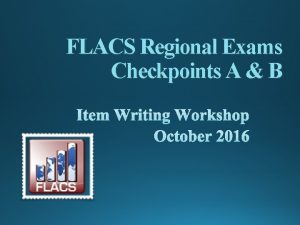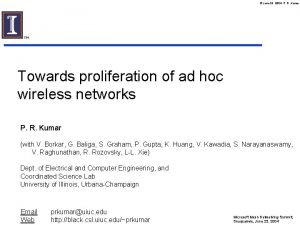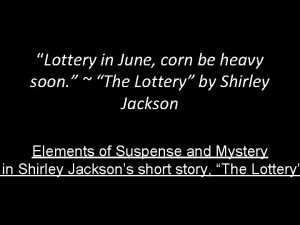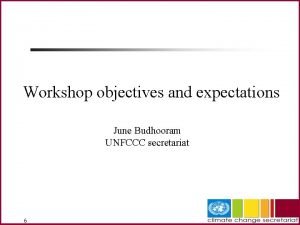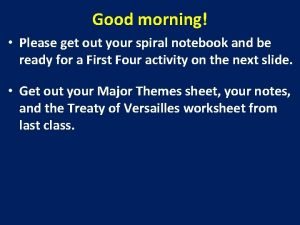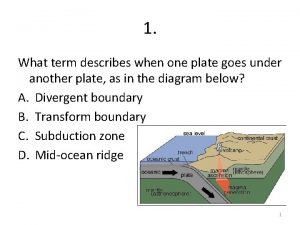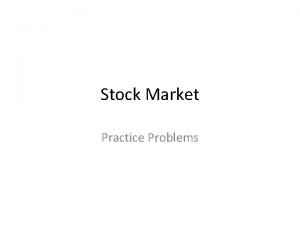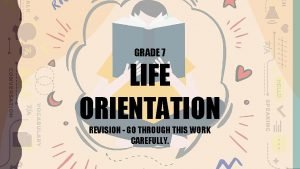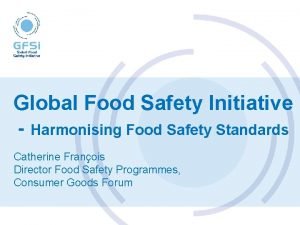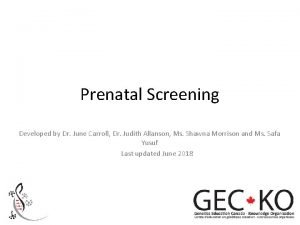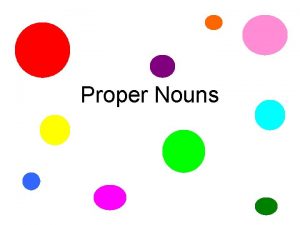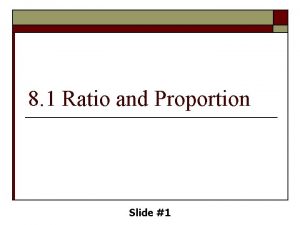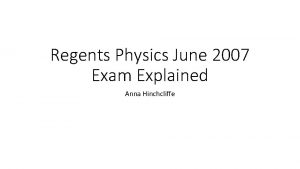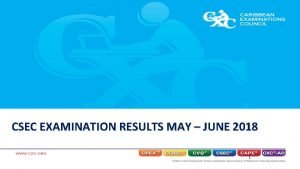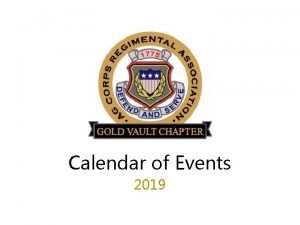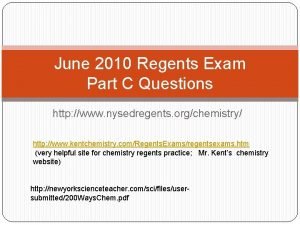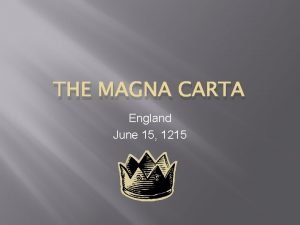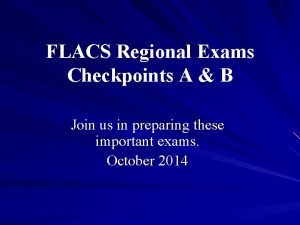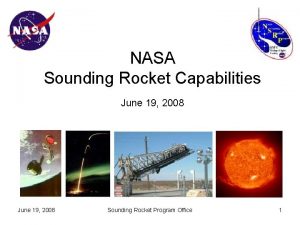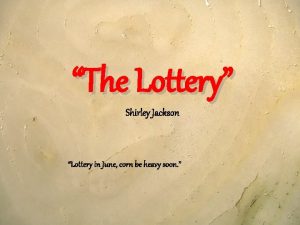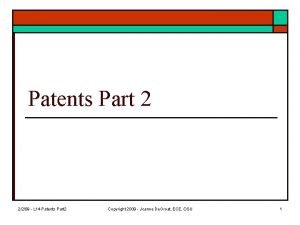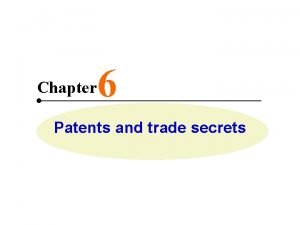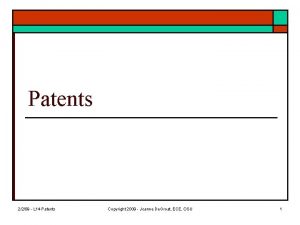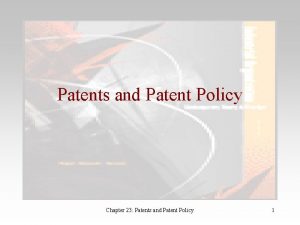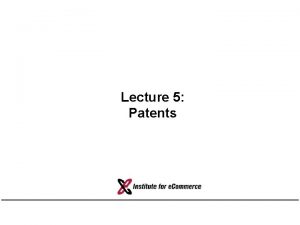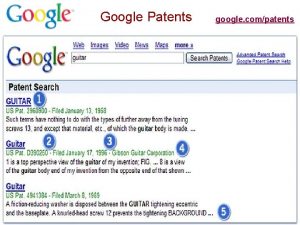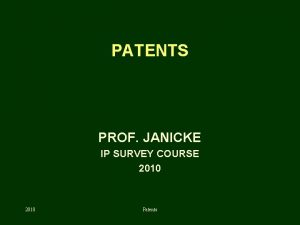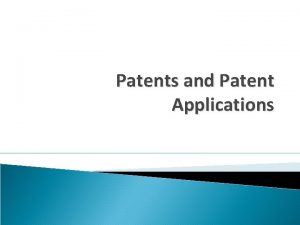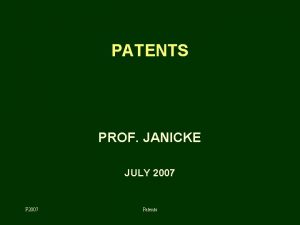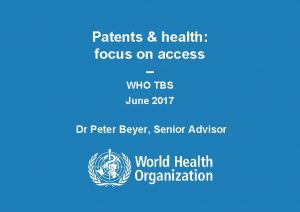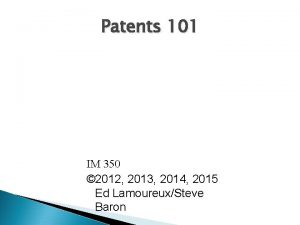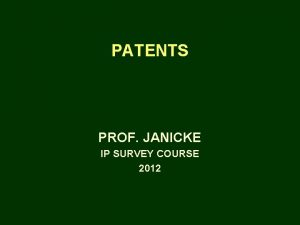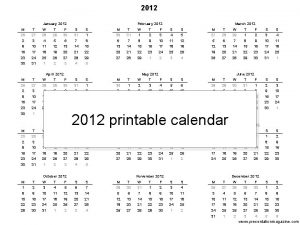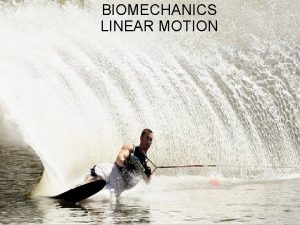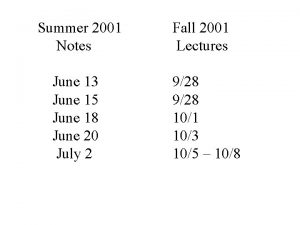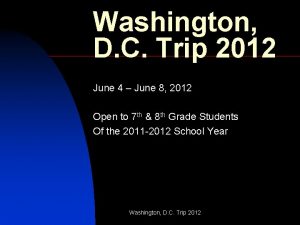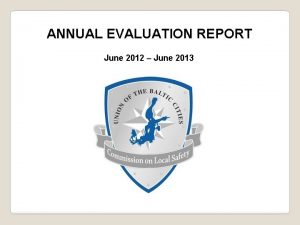Patents June 28 2012 9 30 a m


















































- Slides: 50

Patents June 28, 2012 9: 30 a. m. – 11: 00 a. m. Central Julie Brocketti, Attorney Global Intellectual Property Academy Office of Policy and External Affairs

Julie Brocketti is a Primary Patent Examiner at the United States Patent and Trademark Office (USPTO), Alexandria, Virginia. She examines patent applications in the areas of electrical education, demonstration and simulation. Currently she is on detail assignment as an Attorney Advisor in the Global Intellectual Property Academy in the Office of Policy and External Affairs. Julie has a Bachelor of Science degree in Electrical and Computer Engineering from The Ohio State University and a Juris Doctor from American University Washington College of Law. Julie previously was in house counsel for IGT (International Game Technology) a gaming machine manufacturer in Nevada.

Overview • • What is a Patent? Why get a Patent? Who can file for a Patent? Types of Patents Requirements for Patentability How is a Patent granted? How long does it take to get a Patent in the United States? • Patenting Considerations • Trade Secret vs. Patent 3

What is a Patent? • Property Right: – Right to exclude others from making, using, selling, offering for sale or importing the claimed invention. – Limited term. – Territorial: protection only in territory that granted patent; NO world-wide patent. • Exchange: Inventor discloses invention in exchange for the patent grant and its associated rights. 4

Why Get a Patent? • A patent can be – Sold or licensed, like other property – Used to exclude others from a market – Used to gain entry to a market – Used as a marketing tool to promote unique aspects of a product 5

Who can file for a Patent? • Currently, an application for a patent in the United States is filed by the inventor(s) – The inventors are “the applicant(s)” • America Invents Act (AIA) changes to who can file – An assignee, a person to whom the inventor is under an obligation to assign, or a person who otherwise shows sufficient proprietary interest • May file an application for patent – Each inventor must execute an oath or declaration except that the applicant for patent may provide a substitute statement if • The inventor is deceased, under legal incapacity, or cannot be found or reached after diligent effort, or • The inventor is under an obligation to assign the invention and has refused to make the required oath or declaration – Effective for applications filed on or after September 16, 2012 6

Basis for Protection of Patents and Copyright in the U. S. US Constitution, Article 1, Section 8, Clause 8 –“Congress shall have the power. . . to promote the progress of science and useful arts, by securing for limited times to authors and inventors the exclusive right to their respective writings and discoveries. ” 7

Types of U. S. Patents • Utility – How an invention works – Inventions – Functionality – 20 year term from filing date. • Design – How it looks – ornamental design described & shown – 14 year term from grant date. • Plant – new variety of asexually reproduced plant. – 20 year term from filing date. 8

Utility Patent 9

Design Patent • Protects the way an article looks, including – its shape and configuration, as well as – surface ornamentation applied to the article 10

Plant Patent PP 20, 900 11

Basis for Patent Law in the United States • The Statute: 35 U. S. C. (Patent Code) – Laws enacted by the US Congress • The Rules: 37 C. F. R. (Patent Regulations) – Rules governing the operation of the USPTO; may be changed by the USPTO following the proper procedure • Case Law: Ex parte and In re – The United States has a common law system – Court cases shape the interpretation of laws 12

Major Statutory Areas of Patentability Consideration • 35 U. S. C. § 101 – Utility, Statutory Subject Matter • 35 U. S. C. § 112, 1 st paragraph – Enablement, written description, and best mode • 35 U. S. C. § 112, 2 nd paragraph – Definiteness • 35 U. S. C. § 102 – Anticipation • 35 U. S. C. § 103 – Obviousness 13

35 U. S. C. 101 “Whoever invents or discovers any new and useful process, machine, manufacture, or composition of matter, or any new and useful improvement thereof, may obtain a patent therefore, subject to the conditions and requirements of this title. ” 14

35 USC § 101 Compliance • Step 1 – Is the claim directed to one of the four statutory categories of invention? • Is it a Process, Machine, Manufacture, or Composition of Matter? • Step 2 – The courts have stated that abstract ideas, natural phenomena, and laws of nature are not patent-eligible subject matter • Referred to as “judicial exceptions” to patentable subject matter • A claim that is drawn to a “judicial exception” itself is not in compliance with § 101 • If the claim is drawn to a judicial exception itself, it is not eligible • A particular practical application of a judicial exception is eligible • The courts, including the Supreme Court, have been and remain active in determining the scope of these exceptions 15

35 U. S. C. 112, 1 st paragraph • The specification shall contain – a written description of the invention, and of – the manner and process of making and using it, – in such full, clear, concise, and exact terms as to enable any person skilled in the art • to which it pertains, or with which it is most nearly connected, • to make and use the same, – and shall set forth the best mode • contemplated by the inventor of carrying out his invention 16

35 U. S. C. 112, 2 nd paragraph • The specification shall conclude with – one or more claims • particularly pointing out and • distinctly claiming • the subject matter which the applicant regards as his invention 17

35 U. S. C. 102 • 35 U. S. C. 102 - an invention must be new – An invention lacks novelty (i. e. , is “anticipated”) only if • each and every element as set forth in the claim is found, • either expressly or inherently, • in a single prior art reference – Reference must teach every aspect of the claimed invention either explicitly or impliedly • Any feature not directly taught must be inherently present 18

35 U. S. C. 103 • 35 U. S. C. 103 - an invention must be non-obvious – More than a mere obvious modification of the prior art – Reference teachings must somehow be modified to meet the claims • Modification must be one which would have been obvious to one of ordinary skill in the art at the time the invention was made – The teachings of multiple references may be combined under § 103 19

It’s all about the claims! • Protection is limited to what is claimed • During prosecution, claims are searched, may be rejected, amended, and allowed • Specification may include numerous embodiments and elements – but only subject matter claimed is afforded protection • Examiner works with the Applicant to focus the claims on novel aspects of the invention • Broadest reasonable interpretation during examination – Search of invention may extend to unrelated areas • A claim for a hinged picture frame may be rejected over a disclosure of a toilet seat! 20

37 CFR 1. 77(a): Elements of an Application 1. 2. 3. 4. Utility application transmittal form. Fee transmittal form. Application data sheet – bibliographic information. Specification. --Abstract, title, cross-references to related applications, background of invention, summary of invention, brief description of drawings, detailed description, claims, etc. 5. Drawings (if necessary). 6. Executed oath or declaration. 21

The Patent Process Pre-Examination Processing (Office of Initial Patent Examination) Application Assigned to Examiner Serial No. Assigned Examiners First Action Fees Recorded Applicant Response Tentative Classification, Screened for Sensitive Contents Post-Examination Processing (Office of Patent Publication) Examination Processing Quality Review Initial Data Capture Initial Electronic Capture for Printing and Issue Second Examiner Action Final Rejection or Allowance PICS Electronic Scanning Applicant Response Licensing & Review Security Sensitive Cases Separately Processed Subsequent Examiner Action Administrative Examination, Filing Receipt Mailed Applicant Response Patent Publication Division Receipt & review of allowed case & papers File Maintenance Facility Match Post-Allowance Papers and Fees Final Data Capture Final Preparation and Electronic Capture for Printing and Issue Examiner Patent Printed and Issued Abandonments Examine r Board of Patent Appeals and Interferences Courts LEGEND Normal Processing Sequence Alternate Processing Sequence 18 Month Publication of Patent Application 22

Patent Examination • Patent Examiner reviews contents of the application for compliance with all U. S. legal requirements. • Burden is on the examiner: An applicant is entitled to a patent unless… – Requirements of U. S. Law are not met. 10/3/2020 23

Examiners search the prior art 24

Prior Art - 35 U. S. C. 102 & 35 U. S. C. 103 • Prior Art – Any information available for consideration when determining whether an invention is patentable. – Public information. • Patents, publications, articles, products, information on the internet, etc. • Printed publications – U. S. or foreign – Information available/dated before the filing date of application being examined. 25

Other Types of Prior Art in the U. S. • Prior sales or public use in the United States. – If the U. S. /foreign patent/publication or public use/sale in the U. S. is more than one year before the effective filing date • Applicant is barred from obtaining a patent. • 35 U. S. C. 102(b) • AIA Changes to Prior Art (March 16, 2013) – Prior public use or sale anywhere in the world qualifies as prior art. 26

Grace Periods • Time prior to filing during which public disclosure by an inventor will not be considered prior art • Differs in different jurisdictions. – U. S. : 1 year grace period (35 U. S. C. 102(b)) – EU: No grace period. – JPO: 6 -month grace period, under certain circumstances 27

Public Search Page 28

Public PAIR 29

How long does the process take? • Utility Patents – 22. 6 months avg. for a first office action. – 33. 8 months avg. for total pendency. • Design Patents – 13 months avg. for total pendency. • Time can vary depending on the technology and amount of prosecution. – 641, 142 application backlog • 7, 139 Patent Examiners (May 2012 statistics) 30

Where to Patent? • Patent protection can be an important part of overall business strategy in global marketplace. • Patent rights are territorial – Protection against infringing activities • Only within the country or region in which patent was granted • NO world-wide patent – Must apply for and be granted a patent in each country or region of interest June 2012 31

Who Grants Patents? • National patent offices – E. g. USPTO, JPO, KIPO • Regional patent offices – Grants patents with effect in some or all member countries • European Patent Office (EPO) • Eurasian Patent Convention (EA) • African Regional Intellectual Property Organization (ARIPO) • African Intellectual Property Organization (OAPI) • Patent Office of the Gulf Cooperation Council (GCC) June 2012 32

Patent Cooperation Treaty • PCT – “Patent Cooperation Treaty” – The Patent Cooperation Treaty allows inventors/applicants to file an international patent application but… – There is NO “international patent” – PCT functions as a patent application filing system. – Applicant must still prosecute the international application in each national or regional office where patent protection is desired. 33

Purposes of the PCT • To simplify the process of filing foreign patent applications. – 146 Contracting States • To give every regional and national patent Office the benefit of – A search by a major patent Office – An optional examination by a major patent office. 34

Advantages of the PCT • To file in up to 146 countries with a single international application. • To delay the expenses associated with – Translations – Foreign filing fees – Local associates • To provide an early indication of pertinent prior art and a written opinion as to the novelty, inventive step and industrial applicability of the claimed invention. • To give extra time for assessment of commercial viability in designated States. 35

Patenting Considerations • Conduct cost/benefit analysis – Consider the shelf life of a product, e. g. , changes in technology, style – Consider how the patent will be used, e. g. licensing, to exclude competitors – Consider whether the product can be used outside your market • Determine patentability – Searching yourself vs. engaging a professional searcher • • Choose right patent attorney/agent Preparation of a thorough and accurate application Are there work arounds for the invention? Costs – Patents can be expensive. – Background work can help to keep attorney fees lower – Annuity & Maintenance fees 36

Where to File Business Considerations • Market size and potential of country/region – Where your invention will be used or sold • Manufacturing potential – Where your invention will be manufactured • Industry size and growth – Where you may expand your business – Where research and development facilities are located • Competition activity – Where similar inventions are sold – Where infringement is likely to be a problem • Patent procurement costs June 2012 37

Where to File Patent Law Considerations • Standards of patentability in country/region – Patentable subject matter differences – Prior art differences – Some countries have only a registration system • No substantive examination • Types of protection differ – Patent, inventor’s certificate, utility model, petty patent, patent of addition, certificate of addition, inventor’s certificate of addition, utility certificate of addition, industrial design 38

How much does it cost? Fees • Attorney fees – Hourly fees • USPTO Utility application – – – Filing fee Search fee Examination fee Discount for small entities Issue Fee Maintenance Fees due at 3 ½ , 7 ½ & 11 ½ years – Flat Rates • Design Patents – No maintenance fees – ~2, 000 -$3, 000 Cost varies based on amount of prosecution. ~$5, 000 -$25, 000 39

Provisional Patent Application • A low-cost ($250) way to establish an early effective filing date (priority date) in a non-provisional patent application with fewer formalities. – Specification & Drawings – No claims required. • 12 month window to file a corresponding utility patent application in order to benefit from the priority date of the provisional application. • Caution – will lose priority date for any new matter filed in the utility application. • Provisional application is abandoned automatically at 12 months and is not examined. 40

Electronic Filing - EFS • 2011 result: 93. 1% of applications filed electronically • Web-based tool • Upload. pdf documents • File PCT applications

Patent Infringement in the U. S Occurs when – Without authorization of patent owner: – Making or using the invention – Offer to sell or sells within the U. S. – Import the invention into the U. S. – Actively induce infringement by another 10/3/2020 42

Enforcement Considerations • Enforceability of patents – Effectiveness of enforcement laws and procedures in the country/region of interest • Some countries allow recordation of patent with customs • Enforcement requires patent owner action • Competitor products should be monitored – In stores – At trade shows • Licensing may be beneficial – Limit as to time, geographical area, or field of use June 2012 43

Trade Secret • Any valuable business information – Not generally known – Subject to reasonable efforts to preserve confidentiality • Property that can be bought and sold • Examples – – – June 2012 Formulas (e. g. Coca-Cola®) Manufacturing processes Business strategies Business management information Customer lists Design concepts 44

Trade Secret vs. Patent Trade Secret • • Indefinite Not registered or disclosed Can be separately discovered Remedy only if the secret is illegally appropriated June 2012 Patent • • 20 year term Public disclosure Right to exclude others Remedy for infringement 45

Common Ways to Lose a Trade Secret • Owner or owner-authorized disclosure • Reverse engineering • Independent development • Failure to take adequate steps to prevent disclosure June 2012 46

USPTO Website – www. uspto. gov • Search Patents • IFW • Electronic Filing • Fees

www. Espacenet. com • European Patent Office • Worldwide search • 80+ countries • WIPO search for PCT applications

Resources • http: //www. uspto. gov/inventors/index. jsp – Inventors Resources on PTO Internet site • http: //patft. uspto. gov/ – Searching US patents • http: //www. uspto. gov/patents/init_events/pct/index. jsp – PCT Legal Web site • http: //www. Stop. Fakes. gov – Protecting Intellectual Property Rights • http: //www. ustr. gov/trade-topics/intellectual-property – Office of US Trade Representative • http: //www. wipo. int – World Intellectual Property Organization • http: //www. espacenet. com/access/index. en. html – European patent database • http: //www. ipdl. ncipi. go. jp/homepg_e. ipdl – Japanese patent database June 2012 49

THANK YOU Julie Brocketti Attorney Global IP Academy Office of IP Policy and External Affairs 571. 272. 1500 Julie. brocketti@uspto. gov 50
 Nysedregents chemistry
Nysedregents chemistry Elephant riding in phuket respuestas
Elephant riding in phuket respuestas What is the copyright designs and patents act 1988
What is the copyright designs and patents act 1988 Uspto
Uspto Copyright designs and patents act 1988
Copyright designs and patents act 1988 Insecticide act
Insecticide act Water powered car
Water powered car Definition of trade secrets
Definition of trade secrets Patents
Patents Simproved harry potter world
Simproved harry potter world Advantages and disadvantages of patents
Advantages and disadvantages of patents Milton glaser biography
Milton glaser biography June 21 2019 geometry regents
June 21 2019 geometry regents June safety tips
June safety tips Good morning 1 june
Good morning 1 june June 6th 1944
June 6th 1944 Ciara earley
Ciara earley June's journey
June's journey Memories by lenore hetrick
Memories by lenore hetrick June canavan foundation
June canavan foundation Head start of greater dallas
Head start of greater dallas June 2021 english language paper 1
June 2021 english language paper 1 Holy june
Holy june June 23
June 23 The map shows that allied forces
The map shows that allied forces New irpwm june 2020
New irpwm june 2020 Spanish flacs exam 2018 answers
Spanish flacs exam 2018 answers June ward
June ward Flacs speaking tasks
Flacs speaking tasks June 23
June 23 What does corn be heavy soon mean
What does corn be heavy soon mean June budhooram
June budhooram Good morning please
Good morning please June cheetah wegener
June cheetah wegener June's portfolio includes 177 shares
June's portfolio includes 177 shares Dr june james
Dr june james Life orientation grade 7 term 2 notes
Life orientation grade 7 term 2 notes Companies in june
Companies in june Confined placental mosaicism
Confined placental mosaicism Book is common noun or proper noun
Book is common noun or proper noun What is the first sad memory of young jose rizal
What is the first sad memory of young jose rizal June 20 2008
June 20 2008 June 2010 physics regents answers
June 2010 physics regents answers Cxccxc results 2018
Cxccxc results 2018 2019 june calendar
2019 june calendar Danswer
Danswer January march april may june july august
January march april may june july august 1215 king
1215 king Flacs exam
Flacs exam 19.06.2008 nasa
19.06.2008 nasa Symbolism in the lottery
Symbolism in the lottery

